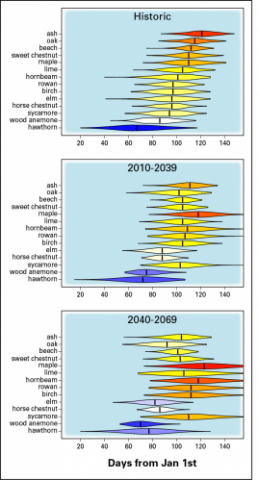Relating biological responses to weather
Smart modelling of the dependencies of biological responses on weather can provide an improved understanding of the potential impacts of climate change and enable more accurate predictions in the short- and long-term, leading to better management decisions. While this may be challenging due to the high-dimensional nature of weather data, these difficulties can be managed through the application of specific mechanistic models or by placing sensible penalty constraints on the sequence of coefficients in regression models that use daily weather records as explanatory variables. One important application for these sophisticated modelling techniques is in phenology.
Phenology is the study of the timing of natural events, such as the commencement of flowering or the nesting of birds. BioSS has been investigating methods for relating phenology to weather since 2001, when it was asked to review the phenology records from the Last family. Since then we have demonstrated that penalised regression can be a powerful tool for phenology, giving easily interpretable results. More recently, in collaboration with the University of Edinburgh, we assessed the performance of various types of statistical models on a classic phenology data set. This series of records was started by Robert Marsham in 1736 and continued by his family until 1958. It consists of timings of leafing and flowering for many species, several of which play an important role in the ecology of woodlands. Understanding climate-driven pressures for change is particularly important in the context of woodlands due to the long-term impacts of management decisions.
Although the penalised regression models were much easier to fit and were able to identify the main features of the relationships between timing of flowering / leafing dates and daily temperatures throughout the year, we found that mechanistic models gave more accurate predictions. For most species, a delaying effect of warm autumn temperatures was evident, in addition to the expected advancing impact of warmer springs. By fitting selected mechanistic models in a Bayesian framework using Markov chain Monte Carlo methods and drawing on temperature simulations from future climate projections, we were able to derive potential distributions of flowering and leafing dates in the time periods 2010-2039 and 2040-2069. In addition to alterations in the timing for individual species, we found that the order of spring events for different species in woodlands is likely to change, which will have important implications for the ecology of woodlands.
We are currently working on a study that focuses on modelling the numbers of aphids flying over a season. This poses additional methodological problems, because the biological response in this case is multivariate and the data are counts of individuals caught. If the results are successful, however, it will aid forecasting of the spread of aphid-transmitted potato viruses.

Violin plots of the distributions of spring events observed by the Marsham family (top) and predicted using model-based projected climates (middle and bottom).

